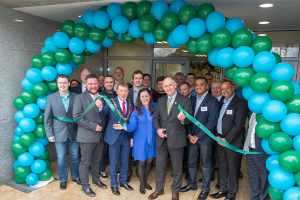EMC’s Napolitano Outlines a Vision of the Software-Led Future #EMCworld2013
![]() “We wanted to take a different approach in the keynotes [at EMCworld 2013] this year,” said Rich Napolitano, President of EMC’s Unified Storage Division, in an interview in the Cube with SiliconAngle Founder/CEO John Furrier and Wikibon.org Co-Founder/Chief Analyst David Vellante, immediately after delivering his keynote speech. “Instead of talking about products, we wanted to talk about a vision to take customers to the cloud.” See an overview of The Cube’s coverage of EMCworld 2013 and link to all the recorded interviews here.
“We wanted to take a different approach in the keynotes [at EMCworld 2013] this year,” said Rich Napolitano, President of EMC’s Unified Storage Division, in an interview in the Cube with SiliconAngle Founder/CEO John Furrier and Wikibon.org Co-Founder/Chief Analyst David Vellante, immediately after delivering his keynote speech. “Instead of talking about products, we wanted to talk about a vision to take customers to the cloud.” See an overview of The Cube’s coverage of EMCworld 2013 and link to all the recorded interviews here.
“ViPR, FAST, NCS, virtualization, are all software, and the thing about software is that it’s malleable,” he said. Storage services such as virus scanning and defragmentation can be added to a software platform that runs across hardware. To demonstrate what that means, during his keynote he injected RecoverPoint, which is normally a separate piece of software, into virtual VNX. Then he instantiated the virtual VNX platform into the cloud, moving the control for a physical storage system out of the data center completely.
“We have a philosophy at EMC of having the right tool for the right job, the right technology for the right use case,” he said. The problem with this approach is that EMC ends up selling several different storage systems that are optimized for different use cases, but that then have to be managed discretely. ViPR is designed to provide a software platform to unify that management across a data center. At a base level, it includes the APIs for all the EMC hardware, providing control path functions to all of those boxes. EMC and third-parties can build services like provisioning on top of that, which greatly increases the flexibility of the system.
Then that management can be tied into other frameworks like Hyper-V, VMware, and OpenStack, and services such as billing, provisioning, and metering can be layered on top of that. Then latency insensitive things like object store can be added to it and hardware can be attached through the ViPR APIs to provide a place where those objects can land, since ViPR itself has no physical assets.
This “allows us to solve the sin that we have many different hardware systems by allowing customers to aggregate the systems they have today” into a much more flexible environment.
“It is important for us to have open frameworks because customers have mixed environments,” he said. “The storage subsystem is agnostic to the host. In the past that meant different flavors of Unix. Today it means OpenStack, Hyper-V. VMware. We need to continue to plug into the physical infrastructures and into the virtual infrastructures. A lot of our business is in Hyper-V, that’s a fact. We need to be in OpenStack because a lot of those guys will go that way. It’s the software that defines those environments.”
A message from John Furrier, co-founder of SiliconANGLE:
Your vote of support is important to us and it helps us keep the content FREE.
One click below supports our mission to provide free, deep, and relevant content.
Join our community on YouTube
Join the community that includes more than 15,000 #CubeAlumni experts, including Amazon.com CEO Andy Jassy, Dell Technologies founder and CEO Michael Dell, Intel CEO Pat Gelsinger, and many more luminaries and experts.
THANK YOU











